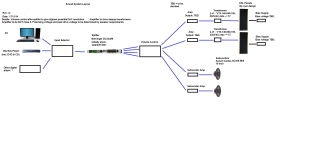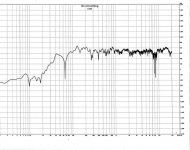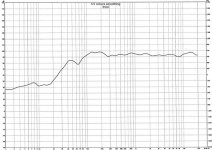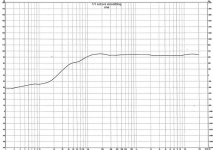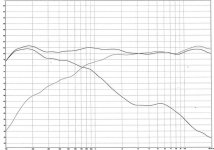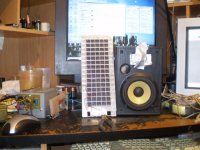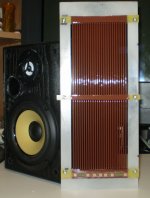hello everyone,
I'm an engineer and musician from Australia who has decided to take the leap into designing and building my own ESL sound system. My goal is to develop a system which sounds infinitely better than my current ~$150 computer speakers, is good value for money, and is flexible enough to handle everything from string quartets and choral music to movies.
The reason I'm posting here is to humbly request that someone who knows what they're doing review my system design. Of course there's no obligation for you to do so, however I think I've done a lot of preliminary work, having read through Sanders and Verwaal's textbooks and numerous online resources. If you feel like helping, please read on...
The speakers will live in my bedroom, which has wooden floor-boards and a ~3.1m ceiling. The layout of the room is in Attachment 1. Walls are black, furniture red and speaker centres + desired listening angles in blue. Ideally I would like to have 15-20 degrees of listenable sound quality; to address this I'm planning to build separate small tweeters which should ensure the high frequencies aren't too focused.
The system I'm proposing is shown in Attachment 2. Details of the speakers are yet to be decided because I'm currently working with Verwaal's Matlab simulation tools to find a good design. Amplifiers will be specified to suit the speakers. The rational behind placing the volume control after the splitter output is to ensure the highest possible DAC resolution.
If you have time to consider my design, the main questions I have are below. The reason I'm asking such basic questions is that once they're settled I can begin ordering parts. (I want to get the whole process finished quickly.)
Regards,
Angus
I'm an engineer and musician from Australia who has decided to take the leap into designing and building my own ESL sound system. My goal is to develop a system which sounds infinitely better than my current ~$150 computer speakers, is good value for money, and is flexible enough to handle everything from string quartets and choral music to movies.
The reason I'm posting here is to humbly request that someone who knows what they're doing review my system design. Of course there's no obligation for you to do so, however I think I've done a lot of preliminary work, having read through Sanders and Verwaal's textbooks and numerous online resources. If you feel like helping, please read on...
The speakers will live in my bedroom, which has wooden floor-boards and a ~3.1m ceiling. The layout of the room is in Attachment 1. Walls are black, furniture red and speaker centres + desired listening angles in blue. Ideally I would like to have 15-20 degrees of listenable sound quality; to address this I'm planning to build separate small tweeters which should ensure the high frequencies aren't too focused.
The system I'm proposing is shown in Attachment 2. Details of the speakers are yet to be decided because I'm currently working with Verwaal's Matlab simulation tools to find a good design. Amplifiers will be specified to suit the speakers. The rational behind placing the volume control after the splitter output is to ensure the highest possible DAC resolution.
If you have time to consider my design, the main questions I have are below. The reason I'm asking such basic questions is that once they're settled I can begin ordering parts. (I want to get the whole process finished quickly.)
- Is the system fundamentally sound? Is there anything that simply won't work or needs to be completely rethought?
- Are there any superior alternatives to the Behringer in a roughly similar price range? I'm happy to modify the Behringer after the warranty expires, but if there's something out there which already has the sound quality of an upgraded Behringer for the same price then I may as well just buy it in the first place and save the hassle.
- Ditto for the Aurum Cantus, is there anything new and much better for a similar price?
- Is Walker's relation ("The Design of Electrostatic Speakers," Verwaal) any good for predicting real world volume performance? I'm currently using it to evaluate whether my designs will be sufficiently loud. I'd like a max of about 100dB(20uPa) at 3.4m. I don't anticipate using that volume very often, if ever, but it seems better to over-spec and operate the speakers in the low to mid ranges than under spec and be constantly peaking it out.
- Are Verwaal's Matlab simulations any good for real world design use? That is, do factors not accounted for in the simulation affect the design so much as to make the simulations useless as a design tool? Or, are they pretty good? I'm using them to predict frequency response and off-axis volume drop-off at varying frequencies.
Regards,
Angus
Attachments
all oke but my question is from where the subs will take over, since these teroids cant go much lower hen 300 hz i believe.
Hi Angus
I would forget about using two ESL panels and use a single segmented ESL panel to cover the midrange and treble - it will retain much more of the coherence that ESLs are famous for and give you a good wide listening area. The theory for the segmented panel is here http://wireesl.weebly.com/uploads/2/4/9/7/24970733/segmented_esl_theory.pdf and there are a couple of spreadsheets about for simulating the response, and people here who are experienced in using them. Yes, Walker's equation is great - though it is strictly for point source ESLs - see the theory for corresponding Walker's equation for line sources. On the same website as above you'll find a paper by Baxandall, in addition to lots of other useful info it has the Walker's eqn for line sources.
Further to comment from WrineX, the input voltage rating for the transformers will be 6V times the ratio of the cutoff frequency to mains frequency, say 30 V for 300 Hz cutoff. But this will give you only 240 V x 300/50 maximum voltage at the output of the secondary at 300 Hz. You should consider stacking a bunch of small toroids (15 VA) which have an unloaded bandwidth in excess of 100 kHz. If you use say 8 in each ESL - two groups of four with the secondaries in series- you will easily get in excess of 4 kVac at the secondaries. Also you can series and parallel the low voltage winding to get the step up-ratio and input voltage rating you want. A couple of warnings though - do not use the transformers with twin 115 V windings - bandwidth is awful. Also do not use commercial ESL transformers, they have very low leakage inductance and are designed for single segment (high load capacitance) ESLs. Segmented ESLs have a much better load characteristic and the bandwidth is maximised by using small low VA transformers which trade some of the winding capacitance for increased leakage inductance.
Let us know how you get on
Best wishes
Rod
I would forget about using two ESL panels and use a single segmented ESL panel to cover the midrange and treble - it will retain much more of the coherence that ESLs are famous for and give you a good wide listening area. The theory for the segmented panel is here http://wireesl.weebly.com/uploads/2/4/9/7/24970733/segmented_esl_theory.pdf and there are a couple of spreadsheets about for simulating the response, and people here who are experienced in using them. Yes, Walker's equation is great - though it is strictly for point source ESLs - see the theory for corresponding Walker's equation for line sources. On the same website as above you'll find a paper by Baxandall, in addition to lots of other useful info it has the Walker's eqn for line sources.
Further to comment from WrineX, the input voltage rating for the transformers will be 6V times the ratio of the cutoff frequency to mains frequency, say 30 V for 300 Hz cutoff. But this will give you only 240 V x 300/50 maximum voltage at the output of the secondary at 300 Hz. You should consider stacking a bunch of small toroids (15 VA) which have an unloaded bandwidth in excess of 100 kHz. If you use say 8 in each ESL - two groups of four with the secondaries in series- you will easily get in excess of 4 kVac at the secondaries. Also you can series and parallel the low voltage winding to get the step up-ratio and input voltage rating you want. A couple of warnings though - do not use the transformers with twin 115 V windings - bandwidth is awful. Also do not use commercial ESL transformers, they have very low leakage inductance and are designed for single segment (high load capacitance) ESLs. Segmented ESLs have a much better load characteristic and the bandwidth is maximised by using small low VA transformers which trade some of the winding capacitance for increased leakage inductance.
Let us know how you get on
Best wishes
Rod
Yes, system like this is Very Feasible !!!
I have been building such systems for quite sometime.
Your initial requirements of dispersion I have obtained with a 3.25"x 9.75" diaphragm.
Verwall's document is a Great Read and as golfnut suggests you should consider a electrically segmented stator design.
My latest design is of this type, although I have not tested it yet as I have yet to obtain the needed resistors for the stator's as well.
Here is another description of my experience that I just did this morning, there are many more in these threads,
http://www.diyaudio.com/forums/planars-exotics/264972-measured-my-esl-attempt.html#post4125027
A complete thread about my latest design and actual build can be found at ESLDIY,
Login
And here,
http://www.diyaudio.com/forums/plan...e-equalization-flat-wire-esl.html#post3348314
But, Unfortunately the site as been undergoing some on going re-construction and even though the thread of description is still there, they have not restored the photos I had posted.
I do not know when or/if they will fix this and I do apologize to all for the broken links that have occurred for whenever I have referenced others to this site in the past.
Some of my design info can in these threads and can be found here,
http://www.diyaudio.com/forums/plan...tor-esl-simulator-esl_seg_ui.html#post2908293
I am not sure what product you are referring to when you mention Behringer, crossover maybe?
I haven't had any issues with any of the Behringer products I have used so far.
I am not familiar with the woofer you have mentioned as well but there are many that have used it and I do know that it is a fine woofer.
I have consider other woofers as well such as the Silver flute, Dayton reference series, HiVi's and even MCM Select 7" aluminium drivers as I have found the THD curves to most of these and they are quite low and very nice.
The current woofers that I have to work with are some Sony 5.25" drivers that I picked up cheap and they work quite nicely up to about 95db.
They do reach their XMax in the 40hz to 60hz range and is what is limiting there overall peak SPL to 95db, but I rarely listened to them that loud at a nearfield position.
Overall the Frequency response of my system is ruler flat with very little to no EQ'ing.
I only used the shelving eq's on my mixer for a makeshift crossover and I am in the process of building a proper crossover and amplifier control center for the system at this very moment.
I will add my most recent accurate and SPL calibrated FR graph of my original system to give you and idea.
The one in my previous post shows some room reflections, but it does show the response of the drivers separate and combined as well as does one of these to show their natural crossover point.
Trying to match the woofer the the panel can be tricky and like most I have found that a sealed box for this type of setup to work the best .
It is compact and as little to no Group delay offering a very fast and transient response using some EQ'ing for any needed low end boost.
Believe it or not a Kick drum sounds amazingly natural and punch as it should considering the roll off in the charts.
Both drivers worked as a whole in the system and there is no localization.
I could not tell that there where actually two drivers being used.
This does not mean that a ported system won't work, I just haven't tried such a system yet except for the 8" sub I used in my very first tests named resurrected.
That sub was tuned quite low to be not boomy and have a very low group delay and it worked quite well.
It gave me the best results by far, but due to its size it didn't meet the requirement of being a desk top system.
These FR charts are of my Highly efficient Black panel before I burned it up and the Sony 5.25" woofer.
Here are pictures of the FR and the setup.
The last picture is of the new segmented design.
FWIW
Jer 🙂
I have been building such systems for quite sometime.
Your initial requirements of dispersion I have obtained with a 3.25"x 9.75" diaphragm.
Verwall's document is a Great Read and as golfnut suggests you should consider a electrically segmented stator design.
My latest design is of this type, although I have not tested it yet as I have yet to obtain the needed resistors for the stator's as well.
Here is another description of my experience that I just did this morning, there are many more in these threads,
http://www.diyaudio.com/forums/planars-exotics/264972-measured-my-esl-attempt.html#post4125027
A complete thread about my latest design and actual build can be found at ESLDIY,
Login
And here,
http://www.diyaudio.com/forums/plan...e-equalization-flat-wire-esl.html#post3348314
But, Unfortunately the site as been undergoing some on going re-construction and even though the thread of description is still there, they have not restored the photos I had posted.
I do not know when or/if they will fix this and I do apologize to all for the broken links that have occurred for whenever I have referenced others to this site in the past.
Some of my design info can in these threads and can be found here,
http://www.diyaudio.com/forums/plan...tor-esl-simulator-esl_seg_ui.html#post2908293
I am not sure what product you are referring to when you mention Behringer, crossover maybe?
I haven't had any issues with any of the Behringer products I have used so far.
I am not familiar with the woofer you have mentioned as well but there are many that have used it and I do know that it is a fine woofer.
I have consider other woofers as well such as the Silver flute, Dayton reference series, HiVi's and even MCM Select 7" aluminium drivers as I have found the THD curves to most of these and they are quite low and very nice.
The current woofers that I have to work with are some Sony 5.25" drivers that I picked up cheap and they work quite nicely up to about 95db.
They do reach their XMax in the 40hz to 60hz range and is what is limiting there overall peak SPL to 95db, but I rarely listened to them that loud at a nearfield position.
Overall the Frequency response of my system is ruler flat with very little to no EQ'ing.
I only used the shelving eq's on my mixer for a makeshift crossover and I am in the process of building a proper crossover and amplifier control center for the system at this very moment.
I will add my most recent accurate and SPL calibrated FR graph of my original system to give you and idea.
The one in my previous post shows some room reflections, but it does show the response of the drivers separate and combined as well as does one of these to show their natural crossover point.
Trying to match the woofer the the panel can be tricky and like most I have found that a sealed box for this type of setup to work the best .
It is compact and as little to no Group delay offering a very fast and transient response using some EQ'ing for any needed low end boost.
Believe it or not a Kick drum sounds amazingly natural and punch as it should considering the roll off in the charts.
Both drivers worked as a whole in the system and there is no localization.
I could not tell that there where actually two drivers being used.
This does not mean that a ported system won't work, I just haven't tried such a system yet except for the 8" sub I used in my very first tests named resurrected.
That sub was tuned quite low to be not boomy and have a very low group delay and it worked quite well.
It gave me the best results by far, but due to its size it didn't meet the requirement of being a desk top system.
These FR charts are of my Highly efficient Black panel before I burned it up and the Sony 5.25" woofer.
Here are pictures of the FR and the setup.
The last picture is of the new segmented design.
FWIW
Jer 🙂
Attachments
Last edited:
[*] Is Walker's relation ("The Design of Electrostatic Speakers," Verwaal) any good for predicting real world volume performance? I'm currently using it to evaluate whether my designs will be sufficiently loud. I'd like a max of about 100dB(20uPa) at 3.4m.
I have found the generalized Walker equation to provide very good agreement with experimental results.
(this includes SPL level, frequency response, and dispersion)
diyAudio member arend-jan created a handy calculator for the generalized Walker equation:
Electrostatic Loudspeaker (ESL) Simulator
I posted some discussion on its use here:
http://www.diyaudio.com/forums/planars-exotics/258958-help-esl-simulator.html#post3988441
http://www.diyaudio.com/forums/planars-exotics/258958-help-esl-simulator.html#post3989632
- Are there any superior alternatives to the Behringer in a roughly similar price range? I'm happy to modify the Behringer after the warranty expires, but if there's something out there which already has the sound quality of an upgraded Behringer for the same price then I may as well just buy it in the first place and save the hassle.
Have you looked at miniDSP?
- Status
- Not open for further replies.
- Home
- Loudspeakers
- Planars & Exotics
- ESL System - Design Review Request

